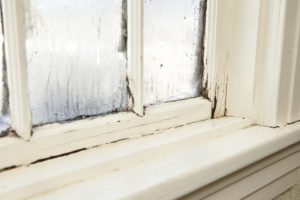Where did that moisture come from?
 Ever wonder why moisture (condensation) forms on your windows? Or, even better, what you can do to help prevent it? Over the years, we have learned that typically this time of the year is the biggest culprit for condensation issues. Below are some simple questions and answers that may help you, understand what is happening in your house.
Ever wonder why moisture (condensation) forms on your windows? Or, even better, what you can do to help prevent it? Over the years, we have learned that typically this time of the year is the biggest culprit for condensation issues. Below are some simple questions and answers that may help you, understand what is happening in your house.
I have moisture on the inside of my windows, what is this?
Whenever there is excess humidity in a home, it appears in the form of water droplets on the coldest area of the wall, which is most homes is lowest portion of glass on a window installed in an exterior wall. Sixth grade science taught us that hot air rises, and cold air descends. As the warm, moist air inside the house cools, it gravitates towards the cooler glass of the window and descends. If you find condensation on a window, it will typically be at the lowest point of the window itself. This is typically not a problem of the window, but evidence of high moisture content in the house.
I just installed new windows, and I still have condensation, why?
The installation of the new windows created a tighter envelope within your home. With your old windows, the moisture simply passed through the leaky old units; however, with new, energy efficient windows, the moisture is stopped and the potential for condensation still exists, and in some cases may be increased.
My neighbor has the exact same house that I do, and he never has condensation on his windows, why?
Every house has a unique heating and cooling pattern. Although they may look identical, how a house is used will determine any potential condensation issues. How you cook, how you clean, your hobbies, and your habits can have a substantial impact on the amount of moisture that is trapped in your house. Just because your house was built by the same builder, during the same year, doesn’t mean they heat and cool the same way!
What can I do to help prevent condensation?
There are some simple steps that you can take that will help the problem. Don’t worry so much about the windows where you can see the effects of excess humidity, concentrate on the real problem and how to address it.
- Leave the vent fan in the bathroom on longer after taking a shower or bath.
- Reduce the amount of moisture that you are putting in the air. Shorter showers or baths is an excellent first step.
- Be aware of your cooking habits. (This is an area that many over look.) Use of a range hood is an excellent way to lower the moisture content in a house.
- Consider opening the fireplace damper for an extended period of time.
If none of these steps seem to assist in addressing the moisture issue, it may be time to consult a professional. A phone call to your heating contractor may be the appropriate next step. Trapped moisture can become an expensive problem that needs to be addressed as soon as possible.